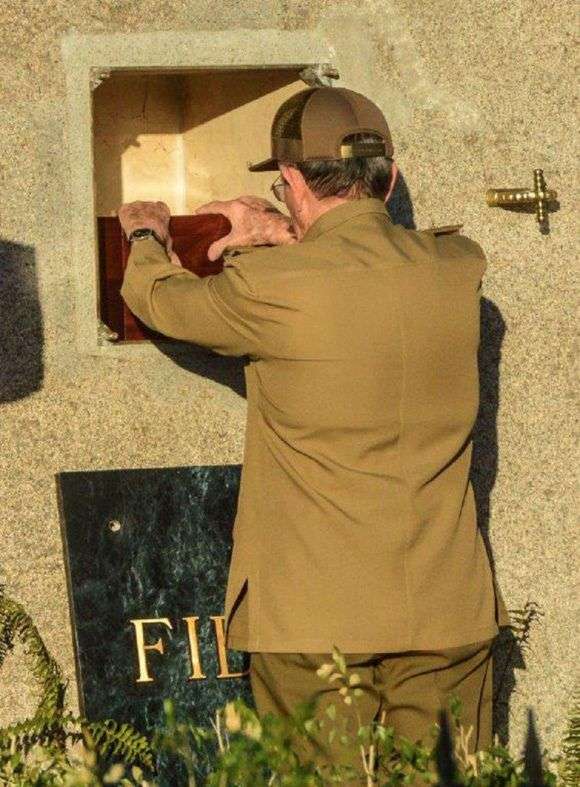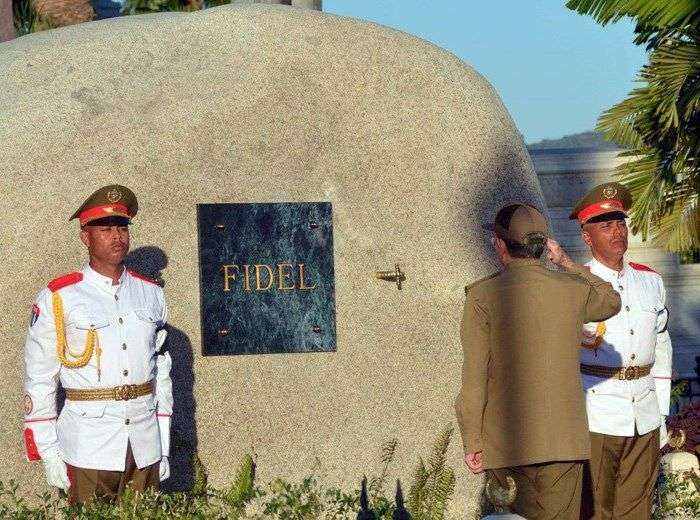The first photographs of where Fidel Castro’s ashes were deposited in Santa Ifigenia Cemetery started circulating hours after the burial ceremony:

Fidel Castro’s ashes were buried this Sunday in Santiago de Cuba. In a “solemn and private” ceremony in Santa Ifigenia Cemetery, the revolutionary leader was bidden his last farewell.
The ceremony was not broadcasted by national television nor did it have live press coverage. Neither have photographs been published. According to what had previously been announced, those present at the ceremony were the family and the topmost Cuban authorities. Invited personalities also attended, among them the presidents of Venezuela, Nicolás Maduro; of Nicaragua, Daniel Ortega; and of Bolivia, Evo Morales; as well as former Brazilian presidents Luiz Inacio Lula da Silva and Dilma Rousseff. Argentine former soccer player Diego Maradona also traveled to Cuba for the occasion.
The funeral cortege departed at around 6:40 am from Antonio Maceo Plaza de la Revolución, after the vigil that followed the mass rally to bid farewell to the Commander. Along its way to the cemetery, the convoy passed through Avenida Patria, built last year and along which the people of Santiago gathered to bid farewell to Fidel, according to the island’s national press.
The site where Fidel Castro’s ashes would rest was not officially revealed until this Saturday, although different sources had located it close to José Martí’s Mausoleum and the pantheon where the remains of the martyrs of the attack on the Moncada Barracks rest. This was confirmed yesterday by his brother, President Raúl Castro, in the speech that closed the mass rally in Santiago de Cuba’s Plaza de la Revolución.
“As was announced by Army General Raúl Castro in yesterday’s mass rally in Santiago de Cuba, Fidel’s ashes are being deposited in a simple ceremony in Santa Ifigenia Cemetery, very close to the mausoleum of National Hero José Martí, his comrades-in-arms in the Moncada, the Granma, the Rebel Army, the underground struggle and internationalist missions,” the newspaper Granma published today.

The tombs of relevant Cuban heroes are located in Santa Ifigenia Cemetery, declared a National Monument. In addition to José Martí, the remains of figures like, Carlos Manuel de Céspedes, considered the Father of the Nation; Mariana Grajales, mother of Lieutenant General Antonio Maceo; revolutionary martyr Frank País; as well as officers and combatants of Cuba’s different revolutionary heroic deeds.
Even though Fidel Castro’s funeral rites have had wide-ranging press coverage in and outside the island, until now the protocol that will govern the site – whether it will have public access once the period of mourning is over or, as speculated, it will have a guard of honor – of his final repose have still not been specified until now.
After the two days of tribute to Fidel in Havana’s José Martí Plaza de la Revolución and covering more than 1,000 kilometers to Santiago de Cuba, traveling in the opposite sense of the Caravan of Freedom in 1959, this Sunday will conclude the national mourning decreed after his death last November 25. However, it is expected that the tributes to his figure will continue at least for what remains of 2016 in different institutions and public places, as well as in the Cuban Parliament sessions.










